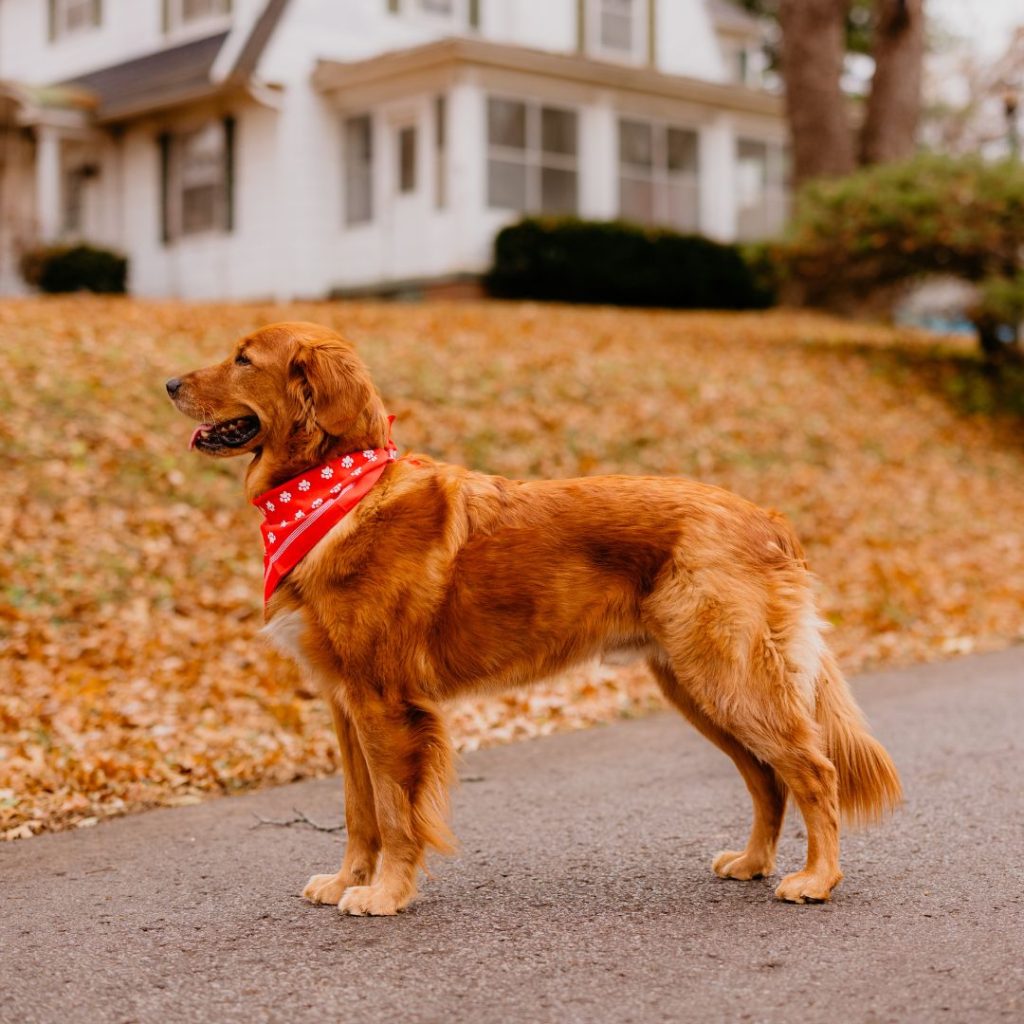
Though dogs often communicate by barking, whining, or growling, the majority of their communication is done through body language. Your dog’s body language includes their overall body posture and stance, as well as the position and movement of their tail, ears, and eyes. Learn more about the meaning behind specific behaviors (like a wagging tail) and how they can reveal what your dog is feeling in the moment.
Why Is Learning Dog Body Language Important?
We humans can use words to communicate, but dogs can’t. Instead, they use sounds, smells and visual signals (body language) to communicate with other dogs—and with us, if we know how to read them. Learning more about dog body language can help you better understand your dog’s needs, recognize when they need support, and strengthen your bond.

TAILS TELL A STORY OF THEIR OWN
A dog’s tail can say a lot about how it’s feeling.Movement is a big part of dog communication because dogs’ eyes can detect motion better than color or fine detail. Even though many of us were taught that a wagging tail means a happy dog, it actually means that your dog is simply aroused. Here are some of the most common tail behaviors and what they mean:
WAGGING SLOWLY
If you see that slow, side-to-side sweep of your dog’s tail, held about halfway between “high” and “low”, it could mean your dog is feeling insecure or uncertain in its surroundings.
WAGGING QUICKLY
A fast tail means an alert dog! A fast, broad wag can be interpreted as friendly and content. If the wagging is fast with very small movements it’s a sign your dog is about to take action.
Wagging to the Left or Right
A dog tail-wagging study published in Current Biology found that tail-wagging mostly on the right side (from the wagging dog’s point of view) is associated with feelings like confidence and companionship. But tail-wagging mostly on the left side is associated with negative emotions like anxiety.
Helicopter Tail
A full-circle tail wag or a full-body tail wag is associated with joy and excitement. You might get a helicopter tail display when your dog knows it’s time for a walk, when they see you again after a separation, or when playing.
HIGH AND TIGHT
When your dog’s tail is held high, they’re likely feeling alert, excited, or assertive (if other dogs are around). If a high tail is wagging very quickly (as if shaking or vibrating) it’s a sign of tension.
TUCKED DOWN LOW
A tail pulled low indicates that your dog is feeling fearful and uncomfortable in its current surroundings. A low tail can also signal submission if other dogs are around. A tail tucked between the legs means a dog feels threatened.
It’s important to keep in mind that different dog breeds can have a different neutral position for their tail— so a high or low tail position can be relative based on how your dog’s tail is set.

HOW ARE THEY STANDING?
Your dog’s posture can also indicate how they’re feeling. Whether they’re showing off their belly or in a playful bow, here’s what your dog’s stance is saying:
LYING ON THEIR BACK
This position is the ultimate invitation to give your dog’s belly a good rub! When your dog is on its back, it means you have a happy pup who trusts you. In extreme circumstances, a submissive pose like exposing the belly could mean your dog feels very stressed and is showing they’re not a threat.
A PLAYFUL BOW
When your dog has their front legs stretched out, leaning down, chest near the floor with their rear end up it means they want to play. Dogs can also use the play bow to signal friendliness to a new dog.
STRAIGHT STANCE
This means that your dog is on high alert and checking its surroundings. Some may say that your dog is “taking it all in” when it’s in this position.
RAISED HACKLES
If your dog’s hair is standing up on the back of its neck and back, it means extremely aroused. Usually indicating stress or curiosity, this form of body language can also mean your dog is really happy or excited.
Mounting Other Dogs (or Legs!)
Mounting is a common dog behavior. Dogs mounting or humping isn’t always about mating, in fact it’s also common in puppies and neutered dogs. If your dog is mounting a toy or pillow, it could be a sign of overstimulation, or they could be acting out if feeling stressed.
In some cases mounting can be a symptom of a medical issue, so keep an eye out for other signs of discomfort and make a visit to your vet if necessary.

FACIAL EXPRESSIONS SPEAK VOLUMES
As dog parents know, dogs have very expressive faces! Dogs can move their eyes, eyebrows, ears and mouth to communicate emotion. In fact, research published by the National Academy of Sciences theorizes that domesticated dogs have evolved different facial muscles so they can communicate better with humans.
YAWNING WHEN NOT TIRED
If your dog is well-rested and still yawning, it’s a sure sign that your pup is stressed.
SMILING
A dog smiling usually indicates happiness, but an apparent smile can also serve as a warning if your pup is really showing its teeth. When a smile becomes a snarl, it’s a warning to anyone or anything around that your dog is feeling aggressive.
EYE CONTACT
Just like people, pups make eye contact with those they love. When you and your dog stare into each other’s eyes it releases oxytocin, a hormone associated with feelings of love and bonding.
Dogs may also look away to show disinterest or diffuse tension. If your dog is feeling stressed they might look away or avoid making eye contact with you.
‘Whale eye’ (when you can see the whites of your dog’s eyes) is a sign of anxiety in dogs. You might notice whale eye when your dog is uncomfortable around someone, or feeling protective of their food or a toy.
Ear Position
When a dog’s ears are pointed up the dog is feeling alert and attentive, possibly curious. Ears pulled flat back against their head are a sign of fear, or possibly aggression. As you might imagine, a dog with relaxed ears is content and calm.
Just like with tail position, it’s important to keep in mind different dog breeds have different neutral positions for ears. Some dogs’ ears are naturally more pointed or prone to hang down, so get to know how your dog’s ear position changes with their mood.

Putting It All Together
Dog body language signals don’t operate independently. You need to consider the context and what all parts of your dog are communicating to get the full picture. Here’s how different emotional states commonly look in dogs:
Submissive
- Lowered head
- Lowered or tucked tail
- Crouching
- Avoiding eye contact
- Exposing the belly
Relaxed
- Head held high
- Neutral stance with weight balanced on all four paws
- Relaxed face – mouth may be open
- Soft eyes
- Tail is neutral or hanging down relaxed (not tucked)
On Alert
- Ears are forward
- Mouth closed
- Eyes focused
- Tail held up
- Standing tall, possibly leaning forward slightly
Playful
- Front end lowered, rear end raised
- Ears up
- Mouth open
- Tail held up (may be wagging)
- Pupils may be dilated
Anxious/Stressed
- Ears lowered
- Tail down
- Walking more slowly
- Pacing back & forth
- Yawning
- Panting
Learn more about identifying and managing dog anxiety.
In Pain
- Flattened ears
- Trembling
- Panting
- Crouching low
- Wide eyes, unfocused stare, or half-open eyes
- Licking/scratching/biting in one area
Aggressive
- Tense stance
- Direct stare
- Teeth bared
- Ears flat back or pricked up
- Raised hackles
- Stiff, high tail, possibly quivering
Hungry
- One paw raised, or pawing at you
- Restlessness
- Whining
- Hovering around food area
- Staring at food bowl
- ‘Puppy dog eyes’
Many of the signals dogs use to communicate hunger are learned behaviors. Dogs are smart and food motivated, and they learn what gets their human to feed them! Learn to discern between true hunger and begging so you can feed your dog responsibly.

Meeting a New Dog
No matter how confident you feel with interpreting your own dog’s body language, never assume that a strange dog is friendly. Don’t let your dog run up to an unfamiliar dog, even if they seem relaxed or playful. Be alert for signs of fear or anxiety in your own dog, and remove them from stressful situations whenever possible.
Teach Kids About Dog Body Language
Studies have shown children are measurably much worse at interpreting dog body language accurately, compared to adults. Don’t leave kids and dogs alone unless they’re well acquainted. If you know that children will be around your dog, give them some helpful pointers on how to behave around your dog, and how to tell when your dog wants to be left alone.
CANINES LOVE STELLA & CHEWY’S
It can be extremely valuable to truly understand your dog’s body language. Not only will this help you get to know your pup better, but it will also ensure that you’re armed to handle their unique behaviors in specific situations. To learn more about all things dogs, check out our variety of dog blogs by visiting Our Blog: For the Pet Obsessed.
GET $3 OFF, INSIDER OFFERS, AND HELPFUL PET CARE TIPS.
By entering your information, you are opting in to receive communication from Stella & Chewy's
